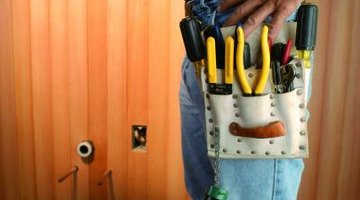How to Replace a Split Receptacle With a GFCI
Split-wired receptacles serve the kitchen counter area of the home because, according to Articles 210.11(C)(1) and 210.52(B)(1) of the National Electric Code (NEC), a minimum of two separate 20A small appliance branch circuits must serve these areas. These receptacles have to be Ground Fault Circuit Interrupting (GFCI) protected, according to Article 210.8(A)(6) of the NEC. The NEC recognizes ground fault circuit interruption protection in one of two ways, by installing GFCI breakers in the service panel or by using GFCI receptacles. GFCI receptacles can't share a common neutral.

Step 1
Tape the branch circuit breakers in the "off" position. If possible, lock the panel so someone will not accidentally turn these breakers on while you are working on the circuit.
Step 2
Remove the old receptacles and save them for reuse. Using the hacksaw, cut the nails securing the old device boxes to the studs and pull them from the wall. Leave the first one attached to the home run cable, the cable running back to the service panel so it doesn't slip down inside the wall cavity.
If the force is with you, you will be able to free the old cable from the stud and use it to pull two runs of the 12/2 ROMEX® to the new device boxes. Actually, the cables will leapfrog boxes. One cable will run from 1 to 3 to 5 to . . . . The second one will run from 2 to 4 to 6 to . . . depending on how many countertop receptacles you are wiring.
If the force isn't with you, you will have to route the runs yourself. The easiest way to do this while doing minimal damage to the finished structure is to route them through the wall behind the kitchen cabinets. Using a razor knife, cut out a small rectangle of wallboard over each stud and then notch the studs with a wood chisel. Lay the cables in these notches and cover with a nail plate for protection. Drop the cables straight down from the box locations and then fish them horizontally through the notches.
Step 3
GFCI receptacles will be installed in the first and second boxes. The first one will provide GFCI protection for receptacles 1, 3, 5, and so on. The second one will provide GFCI protection for receptacles 2, 4, 6, and so on.
One run of 12/2 ROMEX® will be used to bring power from the first box to the second box to feed the line terminals on that GFCI. The other receptacles associated with each GFCI receptacle will be fed from the "Load" side of that GFCI receptacle.
Bring the feed to the second GFCI receptacle out of the bottom of the first device box and into the bottom of the second box so you don't confuse it with the load side wires.
With the new boxes in place, you are ready to start making connections.
Step 4
Using a 6-inch white pigtail, make a 3-way splice to the white, line neutrals, connecting the free end of that pigtail to the "Line" neutral terminal on the GFCI.
Using a 6-inch bare copper pigtail, make a 4-way splice with the other bare copper, grounding conductors in the first box. Connect the free end of this pigtail to the green grounding screw on the GFCI.
Splice the red wire from the home run to the black wire feeding power to the line side of the second GFCI.
Connect the black wire from the home run cable to the line side of the first GFCI.
Step 5
Wire all associated downstream receptacles from the load side of their GFCI receptacle. Downstream receptacles are wired in a normal manner.
Step 6
Carefully push the GFCI receptacles and the regular receptacles back in their boxes and secure in place with 6-32 screws through their plaster ears. Install cover plates. Turn on the CBs. Check for proper GFCI protection using the plug-in GFCI tester.
References
Resources
Writer Bio
Based in Colorado Springs, Colo., Jerry Walch has been writing articles for the DIY market since 1974. His work has appeared in “Family Handyman” magazine, “Popular Science,” "Popular Mechanics," “Handy” and other publications. Walch spent 40 years working in the electrical trades and holds an Associate of Applied Science in applied electrical engineering technology from Alvin Junior College.
Photo Credits
- Jupiterimages/liquidlibrary/Getty Images
More Articles



